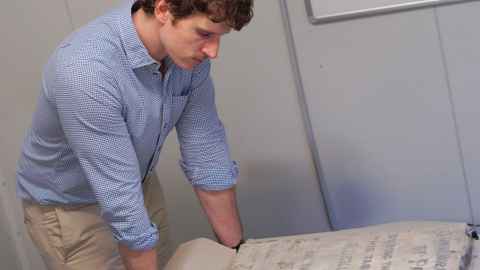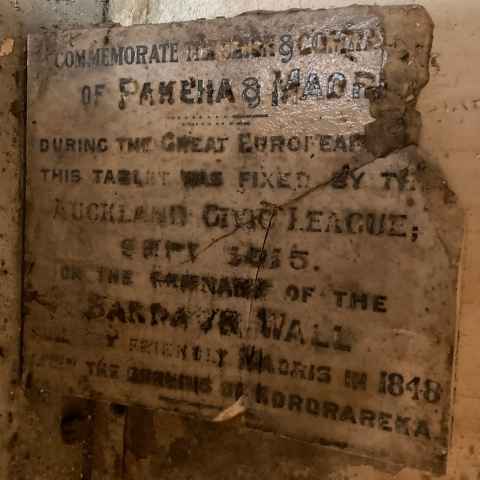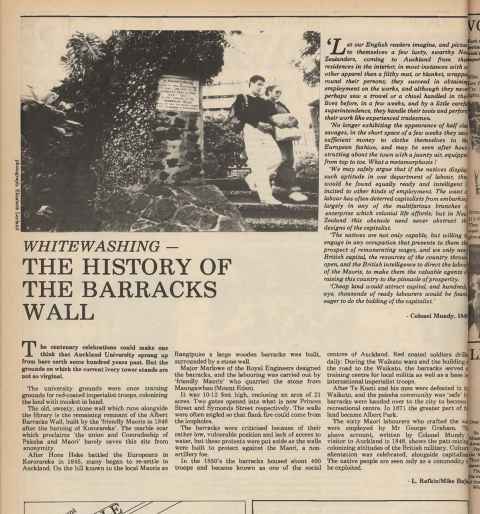Historic plaque found stashed in Old Choral Hall cupboard
30 November 2023
A controversial 1915 plaque that marks a moment in time was found in Old Choral Hall by a construction worker.

A historic plaque, likely to be among New Zealand’s first World War One memorials, has been rediscovered during the major renovation of Old Choral Hall.
The stone plaque was found by a contractor working on the site, tucked away in a cupboard by persons unknown. What is known is that the plaque was removed from the Albert Barracks Wall at the City Campus in 1983. It had been vandalised by someone (or a group) who took exception to the use of the phrase ‘friendly Maoris’ in the inscription.
“That phrase was quite common around 1915 when the plaque was created,” says Faculty of Arts history lecturer Dr Rowan Light.
“By its very nature, it suggests there is another group of Māori who were not friendly, or in fact antagonistic, to the Pākehā settler population.”
The plaque was commissioned in 1915 by the Auckland Civic League, a women’s organisation founded in 1914 by civic leader Ellen Melville, with the goal of improving social conditions in the city.
It reads (sic): “To commemorate the union and comradeship of Pakeha and Maori. During the Great European War, this tablet was fixed by the Auckland Civic League, September 1915 on the remnant of the barrack wall built by friendly Maoris in 1848, after the burning of Kororareka.”
I’d long assumed it had ended up in a tip or been destroyed. We were blown away to hear that it had been rediscovered at Old Choral Hall.
Light, who also works as a curator for the New Zealand Wars exhibit at Auckland Museum, says there’s a lot to unpack in its message.
“It refers to both the First World War, when Māori fought alongside Pākehā in Europe, but also to ‘the burning of Kororāreka’ (Russell) on 11 March, 1845. This was when Northern rangatira, Kawiti and Hōne Heke Pōkai, with several hundred fighters, moved in on the town and cut down the flagpole in protest and frustration at the perceived failure of the British Crown to uphold Te Tiriti o Waitangi.
“It led to a day of fighting and, eventually, burning and pillage that shook the settler population and led to many selling up and heading south to Auckland or fleeing the colony. The fortification was built to ‘reassure’ Aucklanders and was built by Pākehā and local Māori under the supervision of clerk of works George Graham.”
The barracks, apart from the west side wall, were demolished over the 1870s. Rowan says the early 1980s was a fraught time for Māori/Pākehā relations on campus following on from a group of engineering students and their offensive ‘mock haka’, and the 1981 Springbok Tour, which stirred up racial tensions. He says after the plaque was removed from the end of the wall in 1983, it was subsequently forgotten.
“I’d long assumed it had ended up in a tip or been destroyed. We were blown away to hear that it had been rediscovered at Old Choral Hall.”
I suspect the intent was well-meaning when the plaque was erected but ‘friendly Māori’ wouldn’t necessarily represent the nature of the relationship at the time.

Kaiarataki Deputy Pro Vice-Chancellor Māori, Michael Steedman, says the plaque is an important piece of history, but also a window into the mindset of those looking to commemorate relationships at a time when they were fraught.
“You tend not to hear much about who the Māori were who helped build the wall,” he says.
“They were needed, they were paid for the work and they were praised for its quality, but consigned to the status of ‘friendly Māoris’. Some were likely my Ngāti Whātua ancestors who were still in the early years of a relationship with Governors Hobson, Fitzroy, Grey and Browne, dealing with increasing land acquisitions by settlers while trying to retain a foothold in a place where they were increasingly ignored. I suspect the intent was well-meaning when the plaque was erected but ‘friendly Māori’ wouldn’t necessarily represent the nature of the relationship at the time.”
Under University policy, the plaque, which is cracked and has deteriorated to such an extent that its inscription is hard to read, will be moved and gifted to the Auckland Museum, says Light.
“The museum will preserve this taonga for future generations wanting to understand how colonial conflict shaped our local landscape, as well as the ways these stories have been memorialised, interpreted, lost, and then reinterpreted anew."
Memory matters
Dr Rowan Light has a new book out what societies choose to commemorate. Why Memory Matters: 'Remembered Histories' and the Politics of the Shared Past (Bridget Williams Books, 2023) examines why certain aspects of the past are remembered over others, and why it matters, offering a series of case studies of local debates about history in Aotearoa.
Story by Julianne Evans

This story first appeared in the December 2023 UniNews.